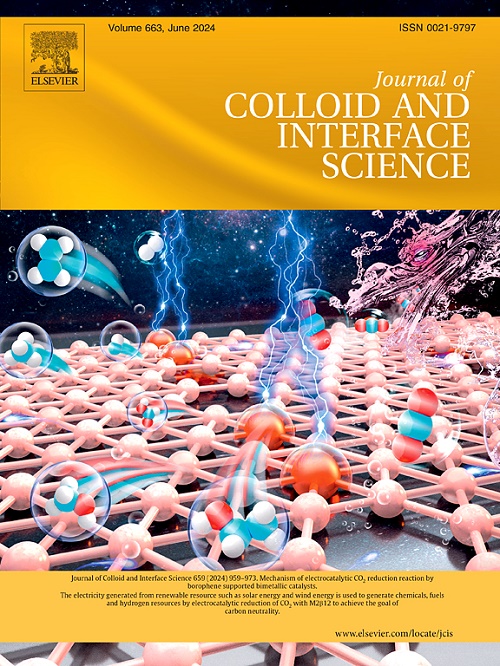原子分散稀土镝氮碳促进氧还原反应。
IF 9.7
1区 化学
Q1 CHEMISTRY, PHYSICAL
引用次数: 0
摘要
基于三维金属原子的过渡金属-氮-碳(MNC)作为一种很有前途的非贵金属催化剂已被广泛用于氧还原反应(ORR),但含4f稀土金属的MNC在很大程度上被忽视,这可能是由于它们的原子半径大,难以与传统前驱体的N掺杂剂配合。在熔融NaCl的辅助下,利用含氮螯合物2,4,6 -三(2-吡啶基)1,3,5 -三嗪(TPTZ)配体与Dy3+进行热解制备了原子分散的镝氮碳(DyNC)纳米片。合成的DyNC以N和O配位的单个Dy原子的特定基团作为ORR的活性位点,表现出优异的性能。在酸性和碱性介质中,其半波电位分别为0.77 V和0.88 V,优于用相同方法合成的铁氮碳(FeNC)。同时,在实际的锌空气电池中验证了DyNC的ORR活性,其最大功率输出为216 mW cm-2,在相同负载下,其性能甚至优于商用铂在碳催化剂(Pt/C)上的性能。此外,理论计算证实,与经典的FeN4片段相比,DyN4O1的过电位更低,为0.570 V,表明其具有更显著的ORR催化性能。本研究为开发含原子稀土金属的非贵金属电催化剂提供了启示。本文章由计算机程序翻译,如有差异,请以英文原文为准。

Atomically dispersed rare earth dysprosium-nitrogen-carbon for boosting oxygen reduction reaction
Transition metal-nitrogen-carbon (M![]() N
N![]() C) based on 3d metal atoms as promising non-precious metal catalysts have been extensively exploited for oxygen reduction reaction (ORR), but M
C) based on 3d metal atoms as promising non-precious metal catalysts have been extensively exploited for oxygen reduction reaction (ORR), but M![]() N
N![]() C with 4f rare earth metals have been largely ignored, most likely due to their large atomic radii that are difficult to coordinate with N dopants using conventional precursors. Herein, atomically dispersed dysprosium-nitrogen-carbon (Dy
C with 4f rare earth metals have been largely ignored, most likely due to their large atomic radii that are difficult to coordinate with N dopants using conventional precursors. Herein, atomically dispersed dysprosium-nitrogen-carbon (Dy![]() N
N![]() C) nanosheets were developed via the pyrolysis of a nitrogen-containing chelate compound of 2, 4, 6-Tri (2-pyridyl) 1, 3, 5-triazine (TPTZ) ligand with Dy3+ under the assistance of molten NaCl. The as-synthesized Dy
C) nanosheets were developed via the pyrolysis of a nitrogen-containing chelate compound of 2, 4, 6-Tri (2-pyridyl) 1, 3, 5-triazine (TPTZ) ligand with Dy3+ under the assistance of molten NaCl. The as-synthesized Dy![]() N
N![]() C features specific moieties of single Dy atom coordinated by N and O as active sites for ORR, displaying excellent performance. The half-wave potentials of 0.77 V and 0.88 V in acidic and alkaline media respectively are superior to those of iron–nitrogen-carbon (Fe
C features specific moieties of single Dy atom coordinated by N and O as active sites for ORR, displaying excellent performance. The half-wave potentials of 0.77 V and 0.88 V in acidic and alkaline media respectively are superior to those of iron–nitrogen-carbon (Fe![]() N
N![]() C) synthesized using the same method. Meanwhile, a practical zinc-air battery verifies the ORR activity of Dy
C) synthesized using the same method. Meanwhile, a practical zinc-air battery verifies the ORR activity of Dy![]() N
N![]() C with a maximum power output of 216 mW cm−2, which is even better than the commercial platinum on carbon catalyst (Pt/C) under the same loading. In addition, theoretical calculations verify that compared to the classic FeN4 moiety, the DyN4O1 exhibits a lower overpotential of 0.570 V, demonstrating that it possesses more significant catalytic performance for ORR. This work provides the inspiration of developing non-precious metal electrocatalysts with atomic 4f rare earth metals for ORR.
C with a maximum power output of 216 mW cm−2, which is even better than the commercial platinum on carbon catalyst (Pt/C) under the same loading. In addition, theoretical calculations verify that compared to the classic FeN4 moiety, the DyN4O1 exhibits a lower overpotential of 0.570 V, demonstrating that it possesses more significant catalytic performance for ORR. This work provides the inspiration of developing non-precious metal electrocatalysts with atomic 4f rare earth metals for ORR.
求助全文
通过发布文献求助,成功后即可免费获取论文全文。
去求助
来源期刊
CiteScore
16.10
自引率
7.10%
发文量
2568
审稿时长
2 months
期刊介绍:
The Journal of Colloid and Interface Science publishes original research findings on the fundamental principles of colloid and interface science, as well as innovative applications in various fields. The criteria for publication include impact, quality, novelty, and originality.
Emphasis:
The journal emphasizes fundamental scientific innovation within the following categories:
A.Colloidal Materials and Nanomaterials
B.Soft Colloidal and Self-Assembly Systems
C.Adsorption, Catalysis, and Electrochemistry
D.Interfacial Processes, Capillarity, and Wetting
E.Biomaterials and Nanomedicine
F.Energy Conversion and Storage, and Environmental Technologies

 求助内容:
求助内容: 应助结果提醒方式:
应助结果提醒方式:


